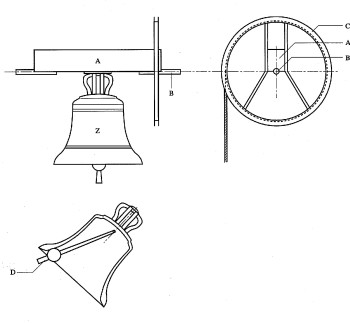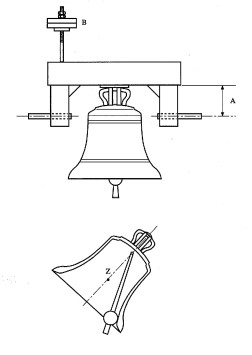Bells in a peal swing back and forth to ring, like this:
The clapper inside the bell hangs down from the top, and it swings up to strike the bell close to its most extreme position, which makes a flying clapper, or it falls down to strike the bell at the same extreme position, which makes the clapper a falling clapper.*
What determines whether the clapper is flying or falling, and what difference does it make? In short, the position of the axis from which the bell is swung and a difference in musical tone and degree of reactive force on its support beam.
A flying clapper is created when the turning axis is at the top of the bell, called a straight swinging axis. The most extreme position of this bell could be up to 90 degrees from the vertical axis.

In this case, the clapper flies up against the top bell wall with a lot of energy, and so the contact time between the clapper and bell is short. For that reason, the tone is clearer and rich in upper overtones. There is a price to pay for this bright bell tone, however—the horizontal force on the beam holding the bell can go up to one and a half times the bell weight at the approximate 60 degree position. Structural engineers need to take this into careful consideration when a peal of multiple bells is being considered for a tower. Not every tower can handle this force.
A falling clapper is created when the turning axis is lower, called a cranked swinging axis. The bell does not swing as high, between 50 and 70 degrees, and the clapper falls to strike against the lower bell wall. The swinging bells in the video above are on cranked swinging axes.

This set-up produces the opposite tone: the contact time between the clapper and bell is longer, so the tone is warmer, dominated more by the hum tone. The more subdued bell sound is coupled with a smaller horizontal force on the support beam. The closer the vertical axis is to the bell’s center of gravity, the smaller the horizontal force. The bonus advantage to a cranked swinging axis is the greater ability to control the ringing tempo. That property of cranked swinging axes often make them preferable to straight swinging axes, since there are usually three, four, five or more bells to coordinate together to make a pleasant peal.
What’s interesting in a cranked swinging axis is that if the distance from the support beam to the turning axis is too short, the bell won’t ring! The clapper swings up with the bell, but doesn’t quite hit the top bell wall, as it would in a straight swinging axis, but the bell swings back to the other side too soon for it to fall on the bottom wall. Likewise, if the distance from the support beam to the turning axis is too long, the clapper doesn’t gain enough energy to properly strike the bell. So there is a sweet spot for the measurement of the turning axis to the support beam, and it’s between 0.25 and 0.45 of the bell diameter.
*All information and images on swinging bells taken from André Lehr, Campanology Textbook, trans. Kimberly Schafer (Stamford, Conn.: The Bulletin of the Guild of Carillonneurs in North America, 2005), 70-71.